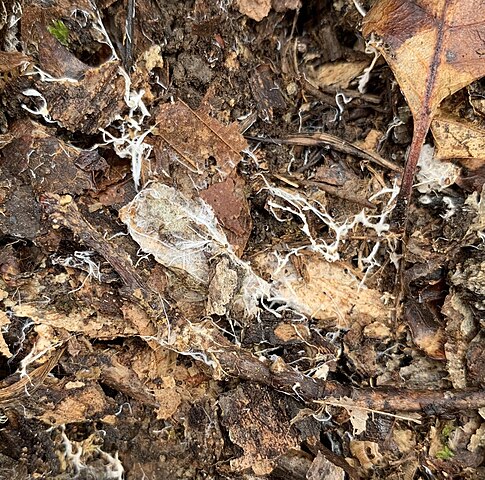
What is a mycorrhizal network? A mycorrhizal network is a web of fungal organisms that spread underground and connect trees together.
When we think about fungus, mushrooms and toadstools spring to mind, but these are only the fruit of the fungus and are produced so that the fungus can spread its spores. The main part of the fungus is made up of long thin strands called hyphae. They grow throughout the soil in search of nutrients. As they grow and feed, they change the pH of the soil, making it easier for them to grow and more difficult for other organisms to grow. They try to eliminate the competition.
Fungi are living organisms but they are different to plants because they don’t have any chlorophyll, which means they can’t make their own energy from sunlight. They are heterotrophs, just like us, and they have to get their energy by eating other organisms. They are also different to plants because they have cell walls that are made of chitin. Chitin is a strong material that is also found in the exoskeletons of crustaceans and insects. The hyphae that make up the fungus are very thin. Each one is only a few cells thick and covered in a very strong cell wall. The hyphae twist together and form mycelium. It depends on the type of fungus, but there can be millions or billions of hyphae in a mycelium.
The mycelium of fungi keep growing outward so long as there are nutrients and things to eat. They are not really limited in the way that the height of a tree is. The largest ever fungi found covered 6.5 square kilometers, which is simply enormous. Because they can grow so big, fungi often come into contact with other fungi. When this occurs, two things can happen. The first thing is that they can try to kill each other. Fungi are very competitive and they can actually produce anti-fungal chemicals, which can kill the other fungi. However, this doesn’t always happen. Sometimes the two fungi will find that they are beneficial to each other and they will merge to make an even bigger fungus. And this is the basis for a mycorrhizal network.
The mycelium spread out in what is called a mycelial network. They often encounter other fungi, but they also encounter plants and trees. When this happens, the mycelium actually grow into the roots of the tree and the tree becomes connected to the mycelial network. The interesting thing is that this doesn’t harm the trees or the fungi. They both gain from it. It is generally a mutual relationship. There are several types of relationships between organisms. You can have mutualistic, where both parties benefit. You can have commensal relationships where one party gains and the other doesn’t gain or lose. And you can have parasitic, where one party gains something to the detriment and harm of the other party. With fungi and trees, it is a mutualistic relationship because by forming a network, they both get something out of it.
What do the fungi get from the relationship? The fungi are looking for a source of carbon. They need carbon to be able to take in nutrients and to grow their hyphae. Being attached to a tree gives them a ready source of carbon. What do the trees get from the relationship? The trees get a communication and transport network. Trees can use the network to transport water, sugar, and nutrients from one tree to another. If some trees are in the shade and cannot photosynthesize as much as others, the plants that can photosynthesize can transport extra water and nutrients to help the plants in the shade grow. Quite often the trees that send the water, sugar, and nutrients are older, well established trees, sometimes called “mother trees”. The fungi keep about 30% of the sugar that is transmitted along the network, which is another benefit they get. The trees can also use the network to communicate with each other. I don’t mean communicate in the way that we do, but they can send chemical signals to each other along the network. These messages can be things like a tree is sick or is not getting enough nutrients, and the other trees respond to that signal. The trees also get access to some nutrients that the fungi are much better at taking out of the soil than they are, such as phosphorous. These networks crisscross the whole forest and are a vital part of the ecosystem. And this is what I learned today.
Try these:
Sources
https://en.wikipedia.org/wiki/Mycorrhizal_network
https://www.kew.org/read-and-watch/whats-a-fungi
https://www.nationalforests.org/blog/underground-mycorrhizal-network
Image By PerytonMango – Own work, CC BY-SA 4.0, https://commons.wikimedia.org/w/index.php?curid=128698638

Pingback: What is the IoT?